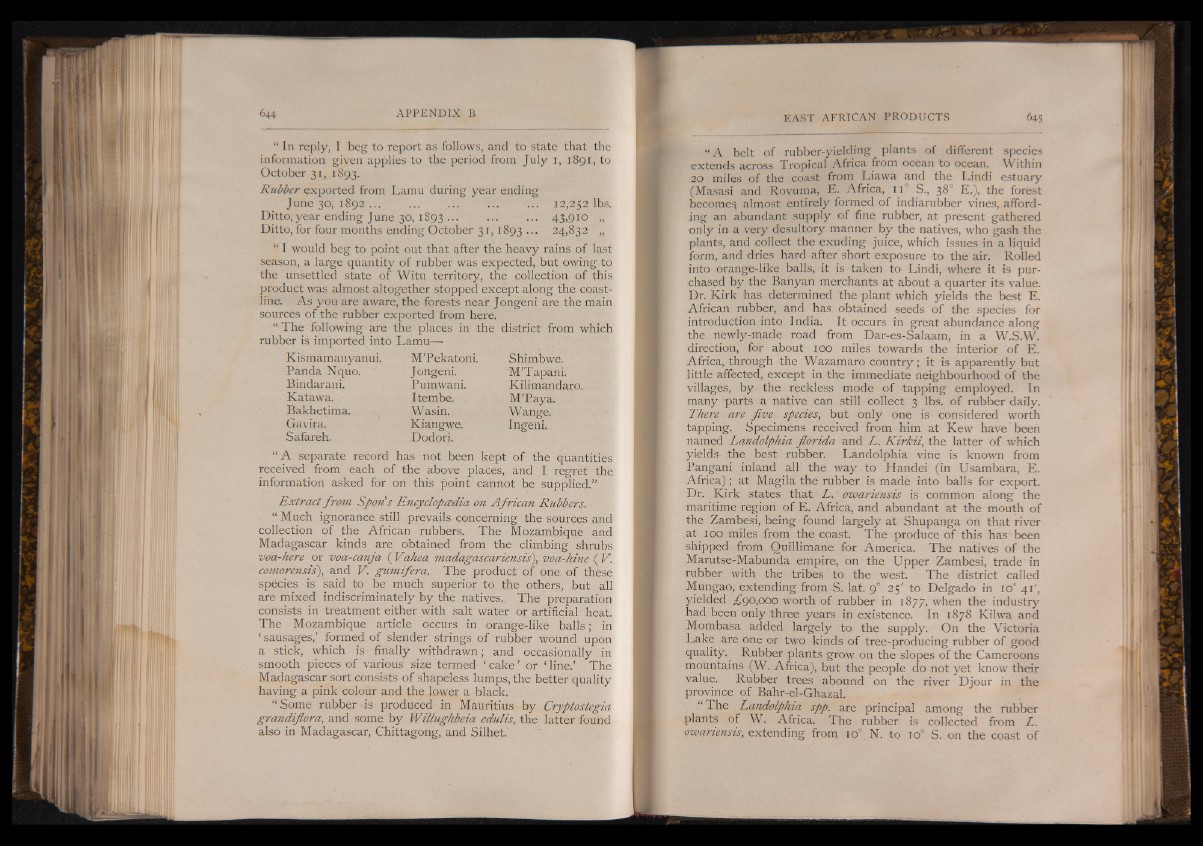
“ In reply, I beg to report as follows, and to state that the
information given applies to the period from July I, 1891, to
October 31, 1893.
Rubber exported from Lamu during year ending
June 30, 1892 ... ... ... ... ... 12,252 lbs.
Ditto, year ending June 30, 1893 43>9io „
Ditto, for four months ending October 31,1893 ••• 24>832 „
“ I would beg to point out that after the heavy rains of last
season, a large quantity of rubber was expected, but owing to
the unsettled state of Witu territory, the collection of this
product was almost altogether stopped except along the coastline.
As you are aware, the forests near Jongeni are the main
sources of the rubber exported from hère.
“ The following are the places in the district from which
rubber is imported into Lamu—
Kismamanyanui. M’Pekatoni. Shimbwe.
Panda Nquo. Jongeni. M’Tapani.
Bindarani. Pumwani. Kiiimandaro.
Katawa. Itembe. M’Paya.
Bakhetima. Wasin. Wange.
Gavira. Kiangwe. Ingeni.
Safareh. Dodori.
. “ A separate record has not been kept of the quantities
received from each of the above places, and I regret the
information asked for on this point cannot be supplied.”
Extract from Spon’s Encyclopoedia on African Rubbers.
“ Much ignorance still prevails concerning the sources and
collection of the African rubbers. The Mozambique and
Madagascar kinds are obtained from the climbing shrubs
voa-here or voa-canja ( Vahea madagascariensis),. voa-hine ¿V.
comorensis), and V. gumífera. The product of one of these
species is said to be much superior to the others, but all
are mixed indiscriminately by the natives. The preparation
consists in treatment either with salt water or artificial heat.
The Mozambique article occurs in orange-like balls ; in
‘ sausages,’ formed of slender strings of rubber wound upon
a stick, which is finally withdrawn ; and occasionally in
smooth pieces of various size termed ‘ cake ’ or ‘ line.’ The
Madagascar sort consists of shapeless lumps, the better quality
having a pink colour and the lower a black.
“ Some rubber is produced in Mauritius by Cryptostegia
grandiflora, and some by Willughbeia edulis, the latter found
also in Madagascar, Chittagong, and Silhet.'
“ A belt of rubber-yielding plants of different species
extends across Tropical Africa from ocean to ocean. Within
20 miles of the coast from Liawa and the Lindi estuary
(Masasi and Rovuma, E. Africa, i i° S., 38° E.), the forest
become^ almost entirely formed of indiarubber vines, affording
an abundant supply of fine rubber, at present gathered
only in a very desultory manner by the natives, who gash the
plants, and collect the exuding juice, which issues in a liquid
form, and dries hard after short exposure to the air. Rolled
into orange-like balls, it is taken to Lindi, where it is purchased
by the Banyan merchants at about a quarter its value.
Dr. Kirk has determined the plant which yields the best E.
African rubber, and has obtained seeds of the species for
introduction into India. It occurs in great abundance along
the newly-made road from Dar-es-Salaam, in a W.S.W.
direction, for about 100 miles towards the interior of E.
Africa, through the Wazamaro country ; it is apparently but
little affected, except in the immediate neighbourhood of the
villages, by the reckless mode of tapping employed. In
many parts a native can still collect 3 lbs. of rubber daily.
There are five species, but only one is considered worth
tapping. Specimens received from him at Kew have been
named Landolphia florida and L . K irk ii, the latter of which
yields- the best rubber. Landolphia vine is known from
Pangani inland all the way to Handei (in Usambara, E.
Africa); at Magila the rubber is made into balls for export.
Dr. Kirk states that' L. owariensis is common along the
maritime region of E. Africa, and abundant at the mouth of
the Zambesi, being found largely at Shupanga on that river
at 100 miles from the coast. The produce of this has been
shipped from Quillimane for America. The natives of the
Marutse-Mabunda empire, on the Upper Zambesi, trade in
rubber with the tribes to the west. The district called
Mungao, extending from S. lat. 90 25' to Delgado in io° 41',
yielded £90,000 worth of rubber in 1877, when the industry
had been only three years in existence. In 1878 Kilwa and
Mombasa added largely to the supply. On the Victoria
Lake are one or two kinds of tree-producing rubber of good
quality. Rubber plants grow on the slopes of the Cameroons
mountains (W. Africa), but the people do not yet know their
value. Rubber trees abound on the river Djour in the
province of Bahr-el-Ghazal.
“ The Landolphia spp. are principal among the rubber
plants of W. Africa. The rubber is collected from L.
owariensis, extending from io° N. to io° S. on the coast of